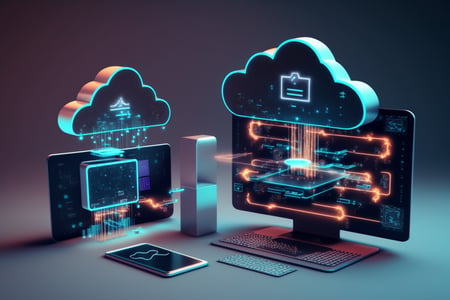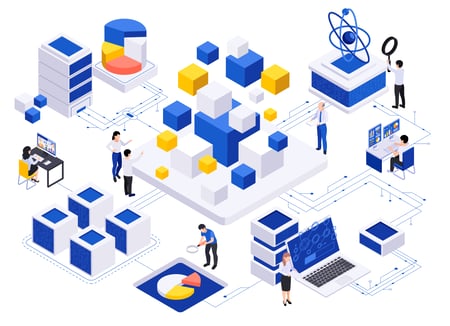
Harnessing the Power of Cloud-Based AI: Emerging Trends in Technology
-
Machine Learning (ML) and Deep Learning - AutoML solutions are the latest trends utilizing cloud-based machine learning algorithms. AWS provides companies with cloud solutions to establish the necessary infrastructure for training ML/DL models, streamlining the development and training processes with enhanced scalability and flexibility.
-
Natural Language Processing - NLP-powered chatbots and virtual assistants, the next frontier in cloud-based NLP services, leverage AWS to customize experiences. These services, infused with Artificial Intelligence, possess the capability to comprehend natural languages and engage effectively with customers.
-
Predictive Analytics - Cutting-edge predictive analytics tools employ intricate AI algorithms to analyze historical data, utilizing various Cloud services such as AWS Data Lakes. By harnessing AWS capabilities, organizations can process vast data volumes and make informed predictions about future trends, empowering them to explore new business prospects.

-
Intelligent Automation - The synergy of Robotic Process Automation (RPA) and AI is transforming how businesses automate tasks, enhancing infrastructure scalability through accelerated cloud deployment. AWS contributes to this intelligent automation, reducing human interventions and optimizing operational efficiency.
-
AI as a Service - AWS joins the ranks of public cloud vendors like GCP and Azure, offering AIaaS. This service empowers companies to create, train, and deploy ML algorithms for diverse automation tasks, exemplifying the potential of deploying AI-based applications in the cloud through AWS.
-
Cognitive Cloud Computing - The fusion of AI and cloud computing in this emerging field is exemplified by platforms capable of understanding, reasoning, and learning from data. Cloud providers such as IBM and Google, along with AWS, introduce cognitive cloud services like cognitive insights, replicating human thought processes in real-time.
-
Business Intelligence (BI) - AWS plays a crucial role in AI-powered data analytics and Business Intelligence in the cloud. This dynamic combination facilitates organizations in gaining actionable insights, especially in gathering market data and analyzing it based on the target audience and competitors, leveraging AWS's computing capacity for seamless data transfer through predictive analytics models.
-
Internet of Things - AWS contributes significantly to managing the generated data by IoT devices in the cloud. Organizations leverage AWS to collect, process, and model data from IoT devices using ML/DL models, showcasing the synergy between AWS and AI in data manipulation and modelling for IoT applications.
Revolutionizing Business Realities: The Transformative Power of Edge Computing
Edge computing is an emerging computing paradigm which refers to a range of networks and devices at or near the user. Edge is about processing data closer to where it’s being generated, enabling processing at greater speeds and volumes, leading to greater action-led results in real-time. It offers some unique advantages over traditional models, where computing power is centralized at an on-premises data centre. Putting computing at the edge allows companies to improve how they manage and use physical assets and create new interactive, human experiences. Some examples of edge use cases include self-driving cars, autonomous robots, smart equipment data and automated retail.
Much of today’s computing already happens at the edge in places like hospitals, factories and retail locations, processing the most sensitive data and powering critical systems that must function reliably and safely. These places require solutions with low latency that do not need a network connection. What makes Edge so exciting is the potential it has for transforming business across every industry and function, from customer engagement and marketing to production and back-office operations. In all cases, edge helps make business functions proactive and adaptive—often in real-time—leading to new, optimized experiences for people.

Edge allows businesses to bring the digital world into the physical. Bringing online data and algorithms into brick-and-mortar stores to improve retail experiences. Creating systems that workers can train and situations where workers can learn from machines. Designing smart environments that look out for our safety and comfort. What these examples all have in common is edge computing, which enables companies to run applications with the most critical reliability, real-time and data requirements directly on-site. Ultimately, this allows companies to innovate faster, stand up new products and services more quickly and open up possibilities for the creation of new revenue streams.
What makes Edge so exciting is the potential it has for transforming business across every industry and function, from customer engagement and marketing to production and back-office operations.

Securing the Cloud: Leveraging Blockchain for Enhanced Transparency and Data Integrity
-
Transparency – Blockchain is a system that provides transparency, thus, any suspicious or secret activity cannot take place on the network. Its sequential storage feature verifies transactions each time, so by creating a strong, connected, and organized chain of blocks, the Blockchain-based cloud storage also creates transaction records to verify ownership and Identity.
-
Prevents Data Tampering – Blockchain offers a way to track and backup transaction history in a way that confirms when the data has been tampered with, this means that it will show when it has been tampered with. It stored the hashes for the data blocks and this gives the data more originality. So if the data is tampered with, it would be glaring.
-
Blockchain is decentralized – Instead of storing all its data transactions in a cloud server, Blockchain breaks it down into small chunks and distributes them across all the participating computer networks. It’s a digital ledger of transactions that lacks a central control point. Each computer, or node, has a complete copy of the ledger, so the problem of data loss in cloud storage is avoided, one or two nodes behind wrongful accessed or corrupted will not result in full data loss. Also, Blockchain removes the need for a middleman or rather, a “trusted third party”.

-
Blockchain is virtually impossible to hack – This is because the data is encrypted, decentralized, and checked by all the participating networks, so once a transaction is recorded on a ledger, it is almost impossible to alter it without the networks noticing because the signatures will be invalidated. There are multiple nodes on a network and every legitimate transaction on the Blockchain system will need the confirmation of all the nodes. To hack the Blockchain, the nodes all have to be hacked at the same time which is nearly impossible and beyond the abilities of cyber criminals today.
To know more about how to incorporate blockchain read here.
Conclusion
In closing, AWS encapsulates the essence of cutting-edge technology. From Machine Learning and NLP to Predictive Analytics and Intelligent Automation, AWS shapes a future where data transforms into actionable insights. Its role in AI as a Service and Cognitive Cloud Computing showcases a commitment to seamless innovation. The alliance between Blockchain and AWS fortifies data integrity and transparency. As we navigate Business Intelligence and the Internet of Things, AWS remains the linchpin, ensuring smooth data transfer and precise management.
In essence, AWS isn't just a cloud provider; it's the driving force propelling us into a future where technology converges to redefine the landscape of businesses and daily life. This blog provides invaluable insights into the imminent cloud landscape, empowering readers to harness the future of technology.


